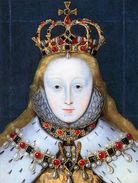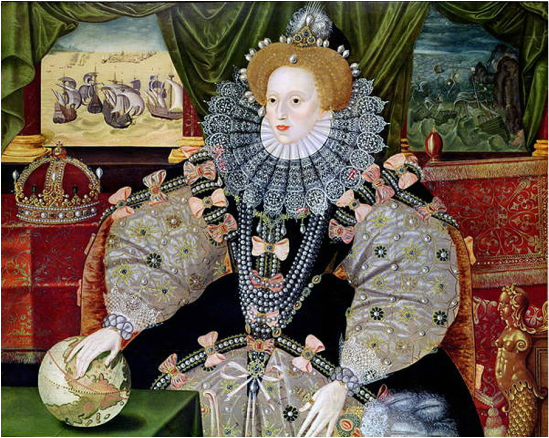This website uses marketing and tracking technologies. Opting out of this will opt you out of all cookies, except for those needed to run the website. Note that some products may not work as well without tracking cookies.
Opt Out of Cookies
 Queen Elizabeth the First by Olivia Pierson Elizabeth Tudor was 25 years old when she inherited the throne from her Catholic sister, Mary. Both were the daughters of the fierce and red-blooded king Henry VIII, but were born of two very different mothers. Mary’s mother, Catherine of Aragon, a pious and devout Catholic, was divorced by Henry but allowed to live in seclusion, thanks to her royal Spanish connections and popularity in the hearts of her English subjects. Elizabeth’s mother, the infamous coquette Ann Boleyn, did not fare quite so well, meeting her death by beheading at the hand of Henry’s executioner. Both princesses received a rigorous education in Renaissance Humanism: law, history, music, theology, philosophy, religion, formal logic, the classical arts, arithmetic, rhetoric and oratory. The Tudor Ladies also had to be fluent in French, Spanish, Latin and Greek. Aside from its spectacular artistic flourishing, The Renaissance was a time of intense religious violence, which was to rage on for at least another century. Catholic power had been challenged by the Protestant Reformation, to which the young Elizabeth was sympathetic. Before her death, Mary had toyed with the idea of beheading her younger sister to avert England’s passing into the hands of a Protestant queen. Thankfully, Mary never quite found it in her heart to carry out this dark threat; Elizabeth was shrewd – she knew when to keep her mouth prudently closed (I’m sure it was hard for her). The most powerful country of this time was Catholic Spain under Phillip II. The Spanish were the dominant navigators of oceans, the early colonisers of the New World (America) and militarily were the mightiest naval force the world had ever seen. The Spanish Armada had free roam of the globe and its ships were a force to be reckoned with on any high sea. Phillip had married Queen Mary but when she failed to produce an heir and instead became sick from a stomach tumour resulting in her death, he was denied any power to the English throne. And so it came to pass that in 1558 England did fall into the hands of a Protestant queen for 45 years. It is now remembered as England’s Golden Age. Compared to other countries of the European Renaissance, England was quite late in coming to the End of the Dark Age party – England did not have a history of high visual art in the way the glorious Italians had shown themselves to be so god-like at. There were no English versions of Michelangelo, Da Vinci, or Raphael, but Elizabeth’s reign was so long and steady it enabled England to achieve some remarkable feats which ensured its ascendancy toward world domination. The two greatest accomplishments of Elizabeth's reign were her commitment to religious tolerance and her navy’s defeat of the Spanish invasion. But it is dramatic literature that the Elizabethan Age is most fondly remembered for. Through the voices of the many poets and playwrights, culminating in William Shakespeare, England beautifully answered the call of the High Renaissance. Elizabeth’s formidable father had broken with Catholic rule and made himself, instead of the Pope in Rome, Head of the Church of England. Catholicism and Protestantism were locked in a bloody battle for the title of “The One True Church” (the medieval mind only ever allows for one). After Henry’s death, Queen Mary returned England back to Catholic rule and Papal authority. Her policy of burning at the stake those who objected strongly endowed her with the well-deserved nick-name “Bloody Mary.” Unlike her sister, Elizabeth did not pursue a policy of persecuting believers for their rival faith. She believed in the Protestant tenet of Liberty of Conscience, reflected in her famous words, “I have no desire to make windows into men’s souls.” The new queen and Parliament ratified the 39 Articles of Faith which were a statement of doctrine designed specifically for the English Church with Elizabeth as its Supreme Governor. Though she required outward conformity to church worship, she allowed for privacy in the homes of her people and sought no jurisdiction over their minds. Catholic or Protestant did not matter to Elizabeth so long as they were loyal Englishmen to her crown. This was a bold step for any 16th Century monarch and separated England from the constant bloodshed which was spilled on a daily basis in France, Spain, Italy, Holland, Germany and Switzerland. Elizabeth certainly had people tortured as well as put to death for high treason, but not religious dissent. She hated extremism in any form, therefore rejected the Puritans. They put their God before their sovereign and Elizabeth could not abide that. She once remarked that she “preferred her loyal Catholics to Puritans.” By the time Elizabeth was 53 years old and had reigned for 30 years, diplomacy between England and Spain had hit an all time low. Spain was not just Catholic, it was fanatically Catholic. Elizabeth had been excommunicated by the Pope for taking her country down its Protestant course. Her ex-brother in law, Phillip II of Spain, did not recognise her as the rightful English sovereign; even though he had also courted her hand in marriage (no man ever was to gain Elizabeth’s hand). Spanish ships were trafficking immense treasures from the New World where they had wealthy colonies in Florida, Cuba, California, Mexico, the Caribbean and South America. During this time of glorious riches, the Spanish were also conducting brutal wars in Holland and France - anywhere within reach of Catholic dominions suffering Protestant agitation. This was the height of the Catholic Counter Reformation. Elizabeth knew she had to be prudent with her treasury, but she sought to help the Dutch by sending soldiers to fight for the Protestants – they were being systematically slaughtered. The Catholic Church was reaching a crescendo in its suppression of the Reformation, which now seemed almost unstoppable, and in its eyes, Elizabeth was its most potent ring-leader. Along with these wild events, Elizabeth was allowing her explorers and pirates to plunder Spanish ships wherever they found them. England had not yet been successful in establishing stable colonies in the New World; Elizabeth had not invested generously in these new and important exploits. She was furious at Spain’s murderous brutality in waging religious wars all over the globe, so in a humorously passive-aggressive fashion, she let Sir Walter Raleigh, Sir Francis Drake, Sir Martin Frobisher and others of her dreaded Sea-Dogs lord it over the Spanish as pirates. These exotic gains helped swell her treasury. But Spain was never going to take this treatment forever, especially from a woman – an excommunicated Protestant! In 1588 Phillip II sent out his powerful Armada to kill Elizabeth and take England back under Catholic rule. France wanted this too, and lent its ports to the Spanish to accumulate its ships for what they expected to be a mighty world-changing event. Elizabeth had seen it coming. Dressing in armour and riding out to Tilbury to speak to her defending troops in person, she roused them powerfully with a passionate speech; “‘My loving people, we have been persuaded by some, that are careful of our safety, to take heed how we commit ourselves to armed multitudes, for fear of treachery; but I assure you, I do not desire to live to distrust my faithful and loving people. Let tyrants fear; I have always so behaved myself that, under God, I have placed my chiefest strength and safeguard in the loyal hearts and good will of my subjects. And therefore I am come amongst you at this time, not as for my recreation or sport, but being resolved, in the midst and heat of the battle, to live or die amongst you all; to lay down, for my God, and for my kingdom, and for my people, my honor and my blood, even the dust. I know I have but the body of a weak and feeble woman; but I have the heart of a king, and of a king of England, too; and think foul scorn that Parma or Spain, or any prince of Europe, should dare to invade the borders of my realms: to which, rather than any dishonor should grow by me, I myself will take up arms; I myself will be your general, judge, and rewarder of every one of your virtues in the field.” The Spanish Armada never made it ashore. The English navy made surprise attacks on the Spanish fleet in the port of Corunna where they were repairing and making preparations for attack. English ships were more agile and their commanders were superior and creative. The Spanish took heavy losses in the battle of Gravelines. When the Armada reached Plymouth England, the weather turned on terrible storms, smashing the invaders against the rocks. The remainder of the fleet turned around to sail for home past Scotland and Ireland, but encountered further storms and losses. By the time the great Spanish Armada made it home over half their fleet was lost along with most of their men. It was a victory which was to have an immense psychological impact on the whole European world in its view of Queen Elizabeth and England. When Elizabeth had taken the throne her country was bankrupt, insignificant and unstable. She used her natural talents to great advantage – wit, courage, intelligence and caution. Above all she created a charismatic cult of personality which rallied the English people firmly behind her. In keeping with the great dramas of her legacy, she cultivated a flamboyant court and studied those around her perceptively, bestowing favour and reward on those who displayed courage, daring and loyalty. This, along with her outrageously lavish style of dressing, encouraged artistic expression in music, dance and literature - the signet of Elizabethan culture. At the beginning of her reign her country was seen by Europe as small and easily conquerable if it came to it. By the time of her death she had transformed England into a major European power in the eyes of the whole world. Even her enemies gave her credit: Pope Sixtus V once said of her; “She certainly is a great queen, and were she only a Catholic she would be our dearly beloved. Just look how well she governs; she is only a woman, only mistress of half an island, and yet she makes herself feared by Spain, by France, by the Empire, by all.” If you enjoyed this article, please buy my book "Western Values Defended: A Primer"
6 Comments
Kevin
18/11/2015 12:17:45 pm
Very good, thank you.
Reply
Rod M
19/11/2015 12:45:17 am
Superbly informative essays. Enlightenment of the digital age, as badly needed now as in the past.
Reply
Olivia
19/11/2015 01:28:06 am
I appreciate that, thanks Rod.
Reply
30/9/2017 12:34:18 pm
A remarkable woman Elizabeth was in her brilliant maneuvering between Spain and the Catholic Church as well as her enlightened thinking on religious tolerance. Thank you, Olivia, for this very informative essay. I also enjoyed your wonderful essay on the philosopher, Hypatia, some time ago, and look forward to reading your book" Western Values Defended." I think you might enjoy some of my work as well and have listed the website that I write under (Restore Our American Republic). Keep up your outstanding work! -
Reply
Elizabeth
13/11/2020 12:39:25 am
My father named me for this queen.
Reply
Leave a Reply. |
Reality Check Radio: Six Hit Shows in One Week on the Assassination Attempt on Trump. NZ is Engaged!
Post Archives
July 2024
Links to Other Blogs |

 RSS Feed
RSS Feed